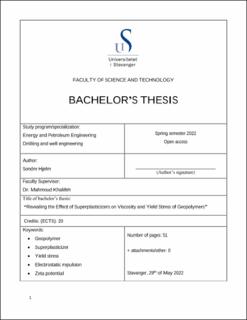| dc.description.abstract | Ordinary Portland cement has for a long time been the prime material used in well cementing, zonal isolation and permanent well abandonment. Cement is considered a necessity in the oil and gas industry for providing zonal isolation and ensuring long-term integrity through the life cycle of a well. Cement manufacturing is highly energy demanding and emission intensive because of the extreme heat required to produce clinker. A shift from the traditional oil and gas industry to an energy sufficient and greener alternative, sparked the interest of new environmentally friendly materials and products. To reduce the high carbon footprint coming from the cement industry, the concept of geopolymers was introduced. Geopolymers aim to replace Portland cement and to provide cleaner alternative to zonal isolation and permanent abandonment of wells.
In this research, the rheological properties and optimum concentration of admixtures on a rock-based geopolymer have been studied. The intention behind this research is to better understand early development in rheological properties and viscosity profiles occurring shortly after mixing. Using a viscometer, viscosity of the slurry was measured according to the API standard “RP 10B-2:2013.”. The rheology data was unit converted and plotted in graphs with concentrations increments of 0.25% from 0 to 1.0% by weight of geopolymer (bwog). Additional measurements were performed with 0.10% concentration bwog with intention to investigate the initial impact of a superplasticizer (SP) at low concentrations. Both shear stress (SS) and viscosity profiles were observed to behave similarly, but with varying degree of magnitude. Difference in both concentration and SP revealed both an increase and decrease in the rheological properties. The theory of electrostatic and intermolecular forces was applied to the study and revealed the effective use of the zeta potential in geopolymers. Theory and interpretation of intermolecular forces made it possible to discuss how and where a potential optimum concentration could exist. Electrostatic repulsion has previously been focused mainly on ordinary Portland cement in this research been re-introduced to the study and development of geopolymers. Observations from the conducted experiments were written down, and results were plotted together with their rheology properties and viscosity profiles. Having graphs overlap each other made it possible to observe how changes in the zeta potential could affect the rheological properties of a geopolymer. One may assume an optimum concentration based on this research, but results should only be considered as indicators. Following the obtained results, it would be recommended for further research to conduct both quantitatively and qualitatively experiments on geopolymers ranging around the observed optimum concentration to ensure a more consistent conclusion. | |
